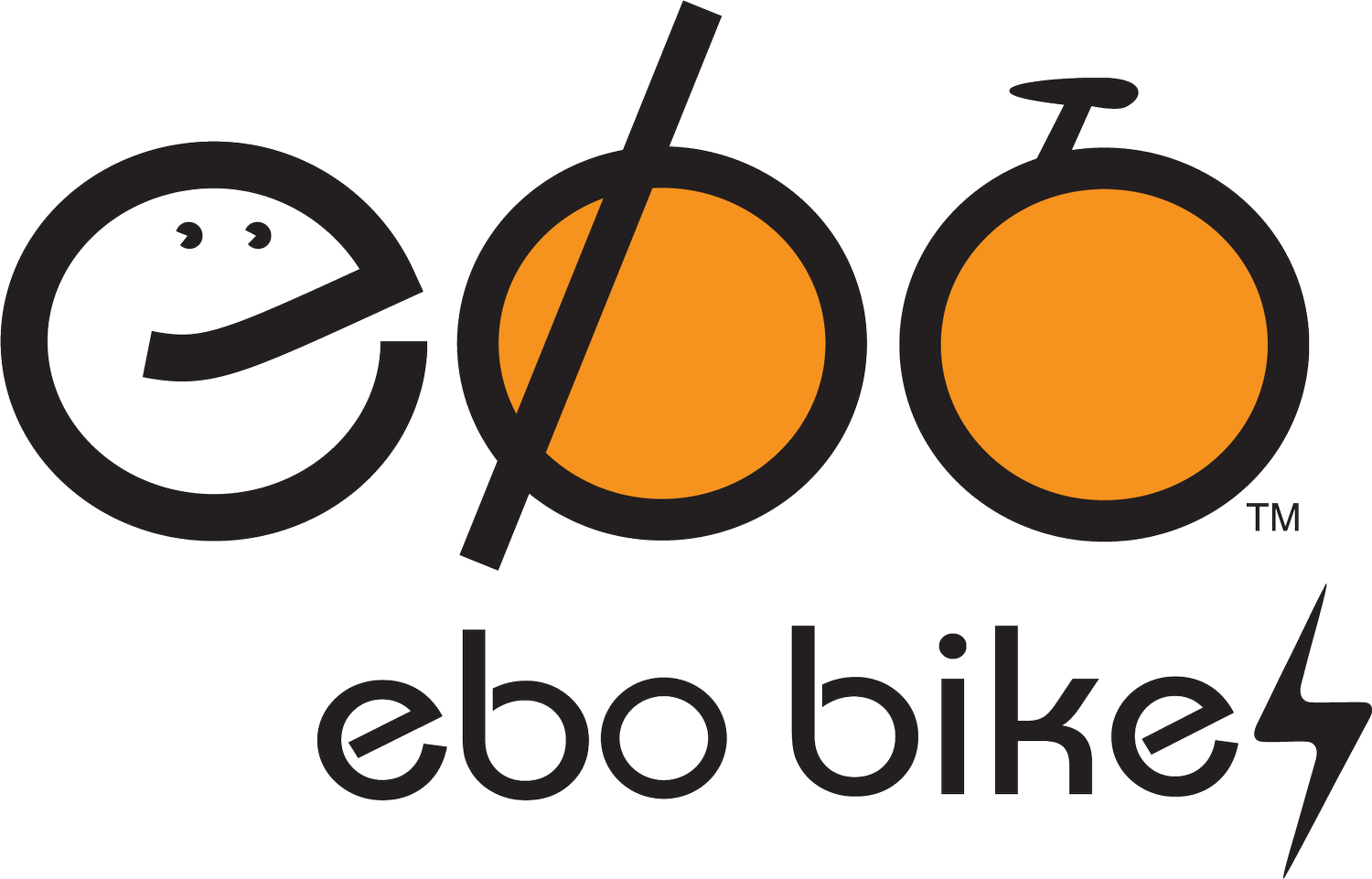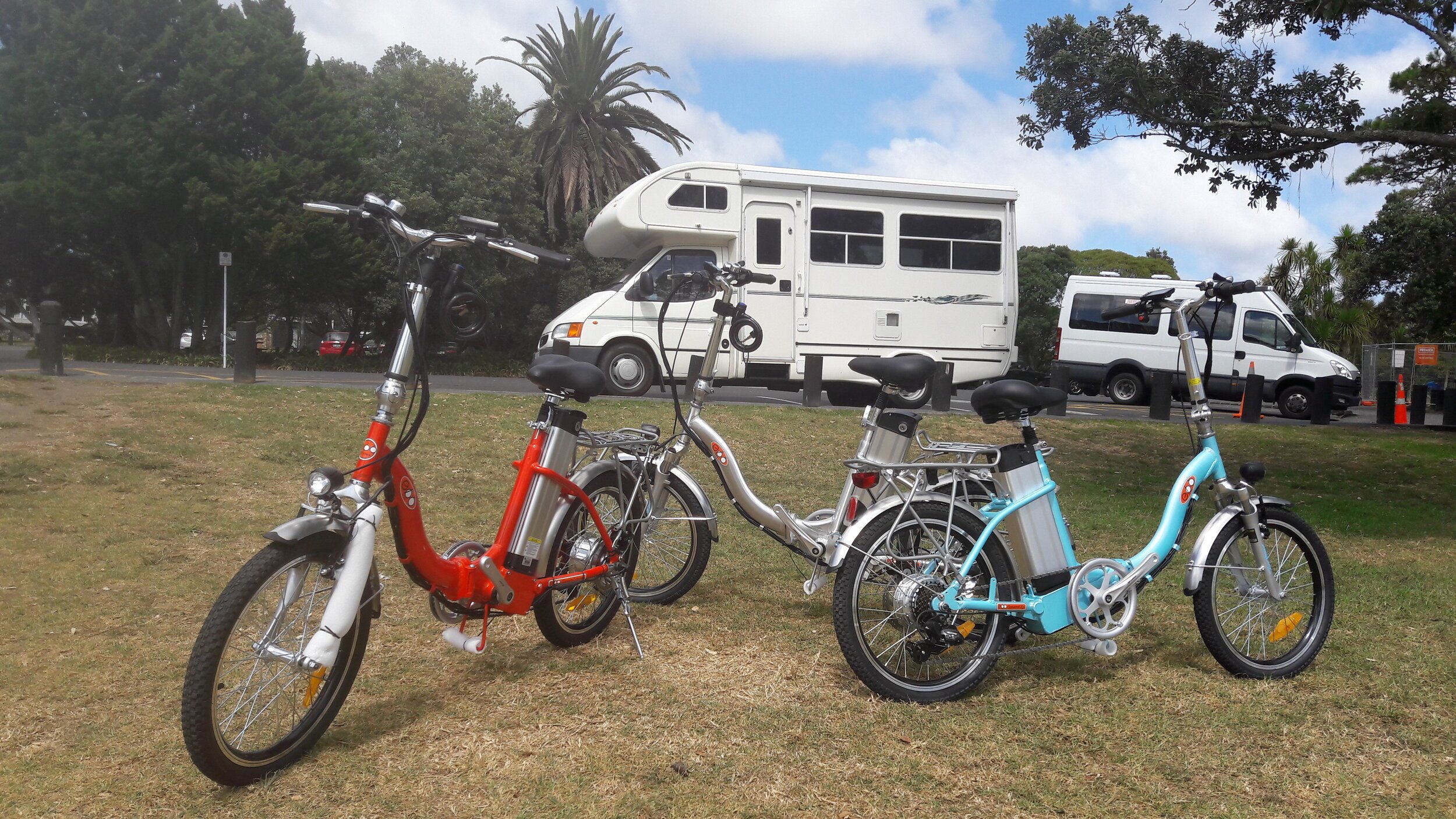Why ride an Ebo?
Neville and his partner on EBO Foldies
Cycling is the new driving. Commuting, cycle-share programs, and expanding bike-lane networks top most big-city traffic agendas. But while attitudes toward cycling are changing, so are bikes themselves. Electric bicycles—also known as e-bikes—have hit the scene and are making a major impression.
While they look like normal two-wheelers, they have a built-in electric motor for propulsion. (It’s not rocket science, but some of the technology in our latest models is very close) So, you ask, if the bike is doing the work, where’s the exercise? Well, the trick to making your e-bike a fitness tool is to use the motor just enough to keep buzzing along at whatever rate satisfies you.
You will be astounded at the power and feeling of speed. And ease! Typically 100Watts will give 15km/hr, 200W will give 20-25km/hr and 300W will give 30km/hr. 30 doesn't sound like much but believe me, on a bike, it's motoring. When you hit a hill just go to a higher power output setting and the engine will give that extra oomph.
You won’t climb at those speeds, but you won’t be disappointed, or even work up a sweat. Here’s the rundown on the benefits of e-bikes, and why you need to own one now. Easier Travel Most people who rule out commuting to work or touring by bike do so because of the energy factor.
Commute Purpose
The combination of cruising and cycling that e-bikes provide saves you some effort (and some sweat), so you can burn some calories but prevent your ride from becoming a full-blown workout that you’re not dressed for. In fact, you’ll arrive fresher, more invigorated, and (let’s be honest) a bit smug that you’ve avoided traffic jams, ridiculous fuel costs and extortionate parking fees - PLUS you are contributing to reducing the environmental pollution.
Real World Test
In a genuine test, a commute from Te Atatu Peninsula to Queen Street in auckland Rush Hour traffic, including parking. The distance was exactly 14 km.
-
Travel time in vehicle = 79 minutes.
Mileage/fuel calculated at $10.36 each way = $20.72 per day.
Parking = $24 per day.
That is a total cost of $45 per day!
-
Travel time on an Ebo electric bike = 36 minutes (to the lift door).
Electricity cost per day (return trip) = $1.28 per day.
Parking = FREE.
That is a total cost of $1.28 per day!
The saving outlined will pay for the bike in 50-60 days commuting. And save you 1.5 hours per day of gridlock horror.
That equates to 1/35th the cost of driving the car.
And this doesn’t even consider the cost of vehicle depreciation, maintenance, wear and tear, insurance, registration and WOF fees.
Recreation
Recreational cyclists come in several hybrids; From cruisey sightseer/ urban chiller-outers to camp(er) based excursionists, to Mountain Bikers, to serious cycle tourers, to hardcore masochistic MAMILs.
Electric bikes completely satisfy all the needs of all but the last group. Cruise to the café, or take a day excursion out at the beach, or tour with bags and off-road MTB capabilities.*
*EBO is about all of these things. Core Strengthening & General Fitness The e-bike can aid you up steep inclines and you will cover ground faster.
Between steering and pedalling, your own output (with power set low) can translate into a solid workout, especially for your core, which has to brace you with every turn. Keep in mind that electric bikes are simply a bike with a battery.
The extra equipment makes it heavier, so you’ll get a genuine soft-but-effective work-out. A Lighter Carbon Footprint Obviously, since electric cycling doesn’t consume hydrocarbon fuel, your e-bike emits a lot less carbon than a car would. In fact, in 2011 the European Cyclists’ Federation found that when comparing electric bikes to cars, the bike & rider emitted just 8.1% per passenger, per kilometre, of CO2 that a car spits out.
ALSO, NOTE; NEW ZEALAND HAS TWICE THE RENEWABLE SOURCE POWER RATIO OF EUROPE, SO THAT FIGURE IS HALVED.
And that can really make a measurable impact on the environment: to translate a study from Transportation Alternatives, it is found that if 10% of New Zealand commuters biked to work just once a week instead of driving or taking public transit, they could cut back on 25 million kilograms of CO2 emissions per year—somewhere around the amount of CO2 released by 20-25,000 New Zealand homes per year.
More Savings With speed (30km/hr) and Wattage (300W) correctly governed, riding an e-bike doesn’t require a special license, registration, or insurance. Therefore, investment and operating costs are almost nothing compared to a car. e-bike prices range between $1,600 and $8,000—about as much as a high-end road bike…
So when you stack up (impending) tolls, parking fees, and tickets, you’ll come out in the green. Batteries need about three hours to fully charge, which provides 30-60 kilometers of range (depending on the model, terrain, and mode of riding). If you only have time for a partial charge, that’s fine too, but do make it a habit of full recharge when convenient. The battery has a cable that plugs into it and any standard wall outlet, so you don’t need to find a charging station. If you stopped at a café for an hour on your trip, you’d get 10 miles of charge during that time. Safer Riding In 2015, 330 Kiwis lost their lives while driving.
Believe it or not, an e-bike poses significantly less risk to your vital signs than a two-ton, four-wheel, speeding vehicle does. For one thing, the speed on an e-bike is nowhere close to those that a car can achieve, and riding in bike lines (assuming you use them) keeps you out of the direct path of cars, lessening the risk you’ll collide with one. That said, it’s not 100% safe; an e-bike carries the same safety concerns as a regular two-wheel bicycle:
Don’t forget your helmet, don’t bike drunk (duh), don’t disregard traffic rules, don’t wear earbuds, and don’t jerk the throttle forward—just like you wouldn’t floor the pedal from a dead stop in your car. It’s also noteworthy that bikes (of any kind) are more stable and controllable in motion than cars are, so accelerating with the throttle allows riders to navigate tighter turns better.
And if you’re fatigued, use the motor. With an electric bike, that’s obviously not a problem. You always have power when you need it.
As with buying a regular bike, getting an e-bike requires the right fit for your purpose. Talk to us at EBO… we know our stuff… a happy customer is a …er…Happy Customer!
Why people ride e-bikes
IT’S A LOT OF FUN… EVERY TIME YOU RIDE THESE THINGS YOU’LL SMILE.
YOU GET AS MUCH EXERCISE AS YOU NEED, EVERY TIME YOU USE IT. FITNESS DOES IMPROVE!
THE COST OF COMMUTE AND SHOPPING IS A TINY FRACTION OF A CAR, AND A LOT MORE ENJOYABLE. No rego, no, parking fees, no speeding tickets, no 100s of meters to walk from a car park… just fun fun fun in the fresh air and sun.
GREEN GREEN GREEN, IN A GENUINE, NOT TOKEN WAY. YOU WIN, AND SO DO THE ROADS, THE TOWN, THE NATION, AND THE PLANET.
SEE #1.




